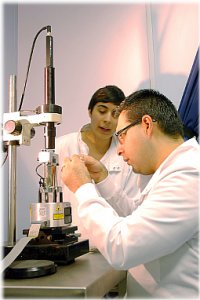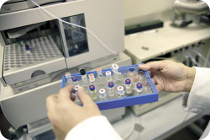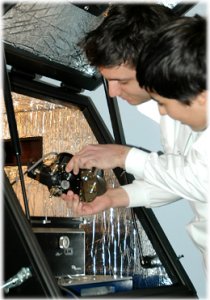 funded byEngineering and Physical Sciences
funded byEngineering and Physical Sciences
Research Council
Syllabus
The first six months of the programme is taught and students will attend lectures, complete projects and also take part in .
Lecture Courses
There are three core modules which all students cover during the programme. Alongside these core modules the students also choose one optional module to study.
Core 1: Underlying Principles of Nanoscience
Part (i) Biomedical Aspects of Nanoscience
| Classes: |
12 lectures in semester 1 (months 1-3) |
The lectures will cover the following topics:
- Physiological hierarchy: animals from the metre to the micrometer
- Physiological hierarchy: general cell structure and ultrastructure; cytoskeletal elements and intracellular transport; channels, pores, endocytosis, phagocytosis, exocytosis
- Overview of human diseases
- Current therapeutics, strengths and limitations
- The science behind using drugs: pharmacokinetics, pharmacodynamics
- Targeting receptors, mechanisms of resistance
- Viruses as prototypical drug carriers
Part (ii) Introduction to Properties of Solids
The lectures will cover the following topics:
- Free electron model of metals. Fermi and Bose statistics. Fermi energy. Conduction properties of metals, electrons in a magnetic field, Hall effect. Cyclotron motion and cyclotron resonance.
- Structural properties of solids. Bravais latttice and unit cell. Bragg scattering. Reciprocal lattice and Brilloun zone. Phonons in solids: optical and acoustic branch. Piezoelectric materials.
- Band structure for electrons in solids. Metals and insulators.
 e mass approximations. Donors and acceptors. Heterostructures and two-dimensional electrons. e mass approximations. Donors and acceptors. Heterostructures and two-dimensional electrons.
- Optical properties of semiconductors. Excitons in semiconductors.
Part (iii) Nanoparticles, Nanomaterials and their Optiacl Characterisation  The lectures will cover the following topics:
The lectures will cover the following topics:
- Introduction to nanoparticles, including dimensionality and general properties. (e.g. surface energys role in reactivity and crystal structure, optical properties and electronic structure).
- Self assembly. Design and interaction of block polymers which self assemble (micelle phase diagrams, peptide gels and DNA). Mesocrystals.
- Production routes for nanoparticles and nanomaterials (colloidal, templating, chemical vapour deposition).
- Optical characterisation techniques (Raman spectroscopy, X-ray photoemission spectroscopy, etc.).
|
Core 2: Introduction to Nanoengineering
Part (i) Nanoengineering Approaches to Regenerative Medicine
| 16 lectures and an EBL assignment in semester 1 (months 1-3) |
The lectures will cover the following topics:
Introductory concepts
- Introduction to Tissue Engineering
- Introduction to polymers
- Mechanical Properties
- Rheology of gel-like materials
Applications |
Source: www.nownano.manchester.ac.uk

|
Fabrication of new developed DSSCs based on TiO2 nanomaterials: Fabrication of new developed hybrid solar cells based on Semiconductor nanomaterials
Book (LAP LAMBERT Academic Publishing)
|
Paper battery?
by edsdeskMon Dec 7, 4:28 pm ET
WASHINGTON (Reuters) Ordinary paper could one day be used as a lightweight battery to power the devices that are now enabling the printed word to be eclipsed by e-mail, e-books and online news.
Scientists at Stanford University in California reported on Monday they have successfully turned paper coated with ink made of silver and carbon nanomaterials into a "paper battery" that holds promise for new types of lightweight, high-performance energy storage.
The same feature that helps ink adhere to paper allows it to hold onto the single-walled carbon nanotubes and silver nanowire films
Some ... some not.
by setArcosBiotechnology, bioinformatics
Emerging technology
Genetic engineering
Synthetic biology, synthetic genomics
Artificial photosynthesis
Anti-aging drugs: resveratrol, SRT1720
Vitrification or cryoprotectant
Hibernation or suspended animation
Stem cell treatments
Personalized medicine
Body implants, prosthesis
In vitro meat
Regenerative medicine
[edit] Energy systems
Emerging technology
Concentrated solar power includes thermal
Engineers develop new materials for hydrogen storage — R & D Magazine
“We are looking for solid materials that can store and release hydrogen easily,” said Olivia Graeve, a professor at the Jacobs School of Engineering at UC San Diego, who has gained international recognition as a nanomaterials manufacturing expert.

|
Solar Cell Nanotechnology
Book (Wiley-Scrivener)
|
 funded byEngineering and Physical Sciences
funded byEngineering and Physical Sciences


 e mass approximations. Donors and acceptors. Heterostructures and two-dimensional electrons.
e mass approximations. Donors and acceptors. Heterostructures and two-dimensional electrons.









